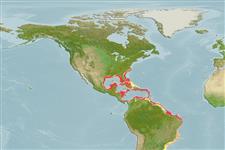Common names from other countries
Environment: milieu / climate zone / depth range / distribution range
Ecology
Marine; reef-associated; depth range 3 - 213 m (Ref. 5222), usually 3 - 35 m (Ref. 40849). Subtropical; 37°N - 30°S, 98°W - 30°W (Ref. 89707)
Western Atlantic: North Carolina, USA to Rio de Janeiro, Brazil, including the Gulf of Mexico and the Caribbean.
Size / Weight / Age
Maturity: Lm ? range ? - ? cm
Max length : 91.0 cm TL male/unsexed; (Ref. 7251); common length : 50.0 cm TL male/unsexed; (Ref. 5217); max. published weight: 10.0 kg (Ref. 5222)
Dorsal
spines
(total): 11;
Dorsal
soft rays
(total): 18-20;
Anal
spines: 3;
Anal
soft rays: 8 - 10. Distinguished by the following characteristics: body and fins black with many large white blotches (Ref. 13608). Compressed, with a large pectoral fin; scales smooth (Ref. 26938); greatest depth of body 2.2-2.5 in SL; body width 2.2-2.9 times in depth; head length 2.5-2.8 times in SL; rounded preopercle, finely serrate, serrae at the angle slightly enlarged (Ref. 089707).
Usually on deep ledges, at depths to 210 m and on reefs, usually in caves or deep crevices (Ref. 7251). Solitary (Ref. 26340) and secretive, darts away when approached or frightened (Ref. 9710). Rarely seen in markets. Major threat to this species is fishing pressure (Ref. 089707).
Life cycle and mating behavior
Maturity | Reproduction | Spawning | Eggs | Fecundity | Larvae
Heemstra, P.C. and J.E. Randall, 1993. FAO Species Catalogue. Vol. 16. Groupers of the world (family Serranidae, subfamily Epinephelinae). An annotated and illustrated catalogue of the grouper, rockcod, hind, coral grouper and lyretail species known to date. Rome: FAO. FAO Fish. Synop. 125(16):382 p. (Ref. 5222)
IUCN Red List Status (Ref. 130435)
CITES (Ref. 128078)
Not Evaluated
Threat to humans
Harmless
Human uses
Fisheries: minor commercial
More information
Common namesSynonymsMetabolismPredatorsEcotoxicologyReproductionMaturitySpawningFecundityEggsEgg development
ReferencesAquacultureAquaculture profileStrainsGeneticsElectrophoresesHeritabilityDiseasesProcessingMass conversion
Tools
Special reports
Download XML
Internet sources
Estimates based on models
Preferred temperature (Ref.
115969): 23.6 - 28, mean 26.7 (based on 502 cells).
Phylogenetic diversity index (Ref.
82804): PD
50 = 0.6250 [Uniqueness, from 0.5 = low to 2.0 = high].
Bayesian length-weight: a=0.00851 (0.00469 - 0.01544), b=3.15 (2.99 - 3.31), in cm Total Length, based on LWR estimates for this species & (Sub)family-body (Ref.
93245).
Trophic level (Ref.
69278): 4.5 ±0.80 se; based on food items.
Resilience (Ref.
120179): Low, minimum population doubling time 4.5 - 14 years (Preliminary K or Fecundity.).
Fishing Vulnerability (Ref.
59153): High vulnerability (56 of 100).
